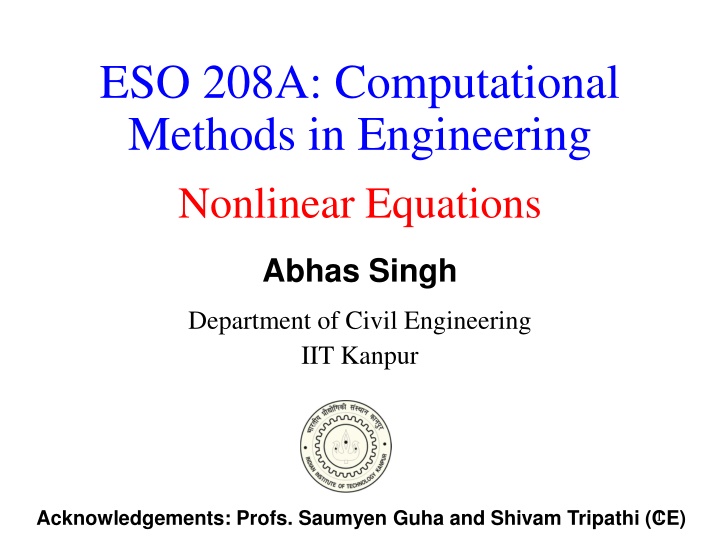
Computational Methods in Engineering: Nonlinear Equations Analysis
Explore the world of nonlinear equations in engineering through methods like Graphical, Bracketing, and Bisection methods. Understand the principles behind finding roots of nonlinear equations efficiently.
Download Presentation

Please find below an Image/Link to download the presentation.
The content on the website is provided AS IS for your information and personal use only. It may not be sold, licensed, or shared on other websites without obtaining consent from the author. If you encounter any issues during the download, it is possible that the publisher has removed the file from their server.
You are allowed to download the files provided on this website for personal or commercial use, subject to the condition that they are used lawfully. All files are the property of their respective owners.
The content on the website is provided AS IS for your information and personal use only. It may not be sold, licensed, or shared on other websites without obtaining consent from the author.
E N D
Presentation Transcript
ESO 208A: Computational Methods in Engineering Nonlinear Equations Abhas Singh Department of Civil Engineering IIT Kanpur Acknowledgements: Profs. Saumyen Guha and Shivam Tripathi (CE) 1
Roots of Non-Linear Equations: f(x) = 0 f may be a function belonging to any class: algebraic, trigonometric, hyperbolic, polynomials, logarithmic, exponential, etc. Five types of methods can broadly be classified: Graphical method Bracketing methods: Bisection, Regula-Falsi Open methods: Fixed point, Newton-Raphson, Secant, Muller Special methods for polynomials:Bairstow s Hybrid methods:Brent s Background assumed (MTH 101): intermediate value theorem; nested interval theorem; Cauchy sequence and convergence; Taylor s and Maclaurin s series; etc. 2
Graphical Method Involves plotting f(x) curve and finding the solution at the intersection of f(x) with x-axis. 3
Bracketing Methods Intermediate value theorem: Let f be a continuous fn on [a, b] and let f(a) < s < f(b), then there exists at least one x such that a < x < b and f(x) = s. Bracketing methods are application of this theorem with s = 0 Nested interval theorem: For each n, let In = [an, bn] be a sequence of (non-empty) bounded intervals of real numbers such that ?1 ?2 ?? ??+1 and lim then ?=1 ?? contains only one point. This guarantees the convergence of the bracketing methods to the root. ? ?? ?? = 0, In bracketing methods, a sequence of nested interval is generated such that each interval follows the intermediate value theorem with s = 0. Then the method converges to the root by the one point specified by the nested interval theorem. Methods only differ in ways to generate the nested intervals. 4
Bisection Method Principle: Choose an initial interval based on intermediate value theorem and halve the interval at each iteration step to generate the nested intervals. Initialize: Choose a0 and b0 such that, f(a0)f(b0) < 0. This is done by trial and error. Iteration step k: Compute mid-point mk+1 = (ak + bk)/2 and functional value f(mk+1) If f(mk+1) = 0, mk+1 is the root. (It s your lucky day!) If f(ak)f(mk+1) < 0: ak+1 = ak and bk+1 = mk+1; else, ak+1 = mk+1and bk+1 = bk After n iterations: size of the interval dn = (bn an) = 2-n (b0 a0), stop if dn Estimate the root (x = say!) as: = mn+1 2-(n+1) (b0 a0) 7
Regula-Falsi or Method of False Position Principle: In place of the mid point, the function is assumed to be linear within the interval and the root of the linear function is chosen. Initialize: Choose a0 and b0 such that, f(a0)f(b0) < 0. This is done by trial and error. Iteration step k: A straight line passing through two points (ak, f(ak)) and (bk, f(bk)) is given by: ? ? ? ??= ? ?? ? ?? Root of this equation at f(x) = 0 is: ? = ??+1= ?? ? ?? ?? ?? ?? ?? ? ?? ? ??? ?? If f(mk+1) = 0, mk+1is the root. (It s your lucky day!) If f(ak)f(mk+1) < 0: ak+1 = ak and bk+1 = mk+1; else, ak+1 = mk+1and bk+1 = bk After n iterations: size of the interval dn = (bn an), stop if dn Estimate the root (x = say!) as: = ?? ?? ?? ? ?? ? ??? ?? 10
Regula-Falsi or Method of False Position y = f(x) f(ak) mk+1 bk ak f(bk) 11
Example Problem ? ? = ? ? ? = 0 True solution = 0.5671 Set up a scheme as follows: Iterations xl xu xk e er 0 0(guess) 1(guess) s.t. f(xl)f(xu) < 0 12
Open Methods: Fixed Point Problem: f(x) = 0, find a root x = such that f( ) = 0 Re-arrange the function: f(x) = 0 to x = g(x) Iteration: xk+1 = g(xk) ??+1 ?? ?? Stopping criteria: ? Convergence: after n iterations, At the root: = g( ) or - xn+1 = g( ) - g(xn) Mean Value Theorem:? ? ? ?? = ? ? for some ? ?,?? ? ?? ??+1 ?? = ? ? ( - xn+1)= g ( )( - xn) or en+1 = g ( ) enor Condition for convergence: g ( ) < 1 As ?? ?, ??+1 = ? ? = constant ?? 13
Open Methods: Fixed Point y = g(x) y = x y = x y = g(x) x3 x0 x2 x1 x1 x0 x3 x2 Root Root 14











